coolant temperature JEEP WRANGLER 2007 JK / 3.G Owners Manual
[x] Cancel search | Manufacturer: JEEP, Model Year: 2007, Model line: WRANGLER, Model: JEEP WRANGLER 2007 JK / 3.GPages: 467, PDF Size: 8.83 MB
Page 205 of 467
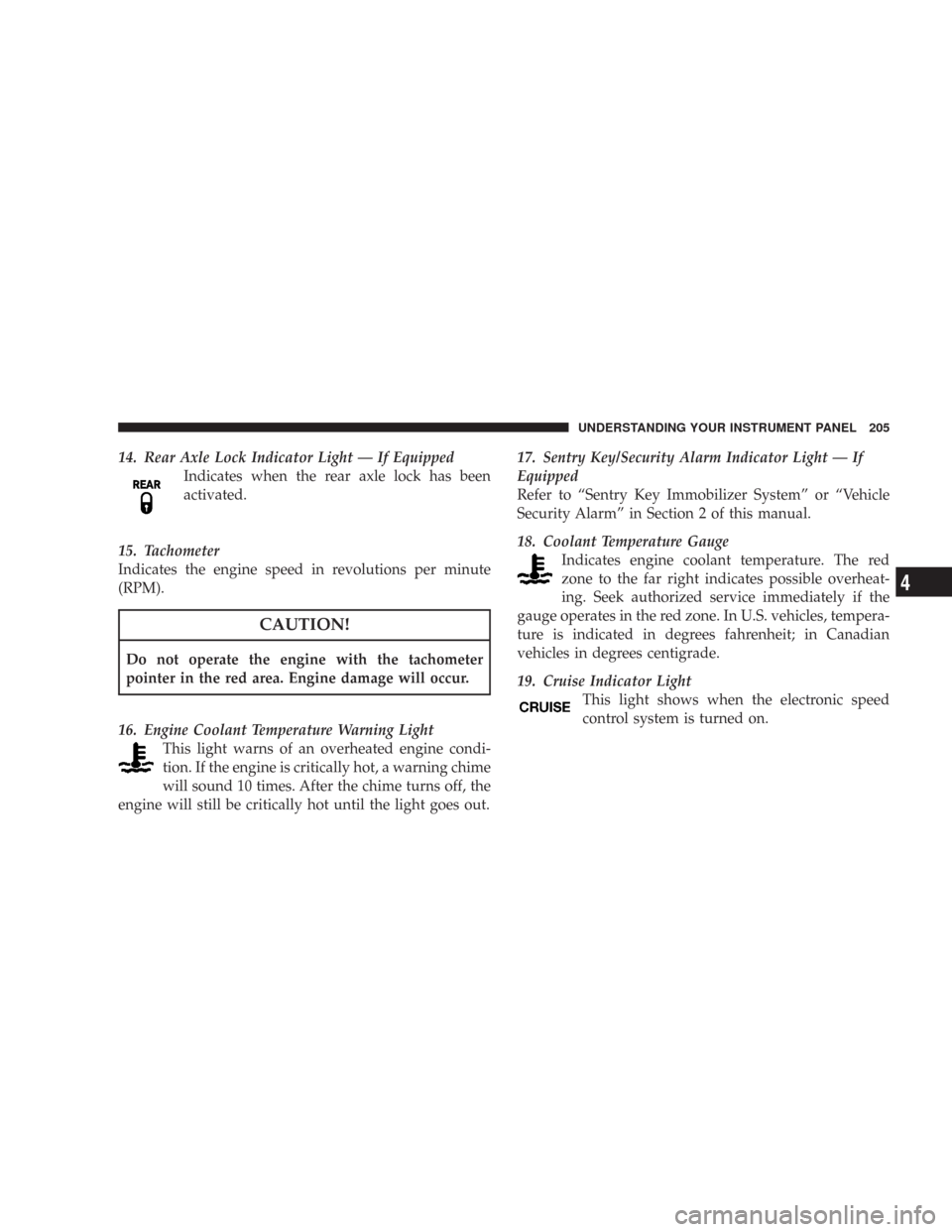
14. Rear Axle Lock Indicator Light — If Equipped
Indicates when the rear axle lock has been
activated.
15. Tachometer
Indicates the engine speed in revolutions per minute
(RPM).
CAUTION!
Do not operate the engine with the tachometer
pointer in the red area. Engine damage will occur.
16. Engine Coolant Temperature Warning Light
This light warns of an overheated engine condi-
tion. If the engine is critically hot, a warning chime
will sound 10 times. After the chime turns off, the
engine will still be critically hot until the light goes out.17. Sentry Key/Security Alarm Indicator Light — If
Equipped
Refer to “Sentry Key Immobilizer System” or “Vehicle
Security Alarm” in Section 2 of this manual.
18. Coolant Temperature Gauge
Indicates engine coolant temperature. The red
zone to the far right indicates possible overheat-
ing. Seek authorized service immediately if the
gauge operates in the red zone. In U.S. vehicles, tempera-
ture is indicated in degrees fahrenheit; in Canadian
vehicles in degrees centigrade.
19. Cruise Indicator Light
This light shows when the electronic speed
control system is turned on.
UNDERSTANDING YOUR INSTRUMENT PANEL 205
4
Page 269 of 467
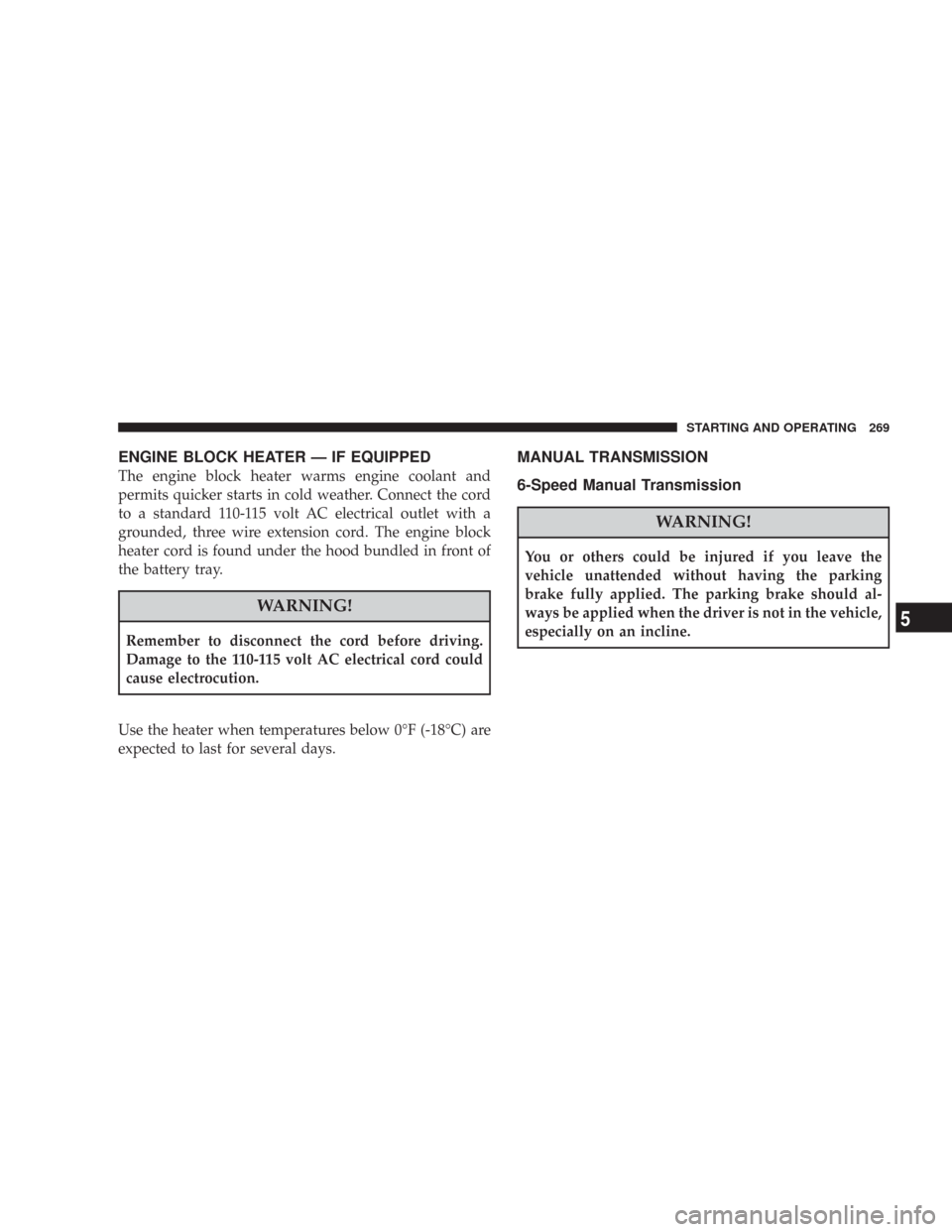
ENGINE BLOCK HEATER — IF EQUIPPED
The engine block heater warms engine coolant and
permits quicker starts in cold weather. Connect the cord
to a standard 110-115 volt AC electrical outlet with a
grounded, three wire extension cord. The engine block
heater cord is found under the hood bundled in front of
the battery tray.
WARNING!
Remember to disconnect the cord before driving.
Damage to the 110-115 volt AC electrical cord could
cause electrocution.
Use the heater when temperatures below 0°F (-18°C) are
expected to last for several days.
MANUAL TRANSMISSION
6-Speed Manual Transmission
WARNING!
You or others could be injured if you leave the
vehicle unattended without having the parking
brake fully applied. The parking brake should al-
ways be applied when the driver is not in the vehicle,
especially on an incline.
STARTING AND OPERATING 269
5
Page 381 of 467
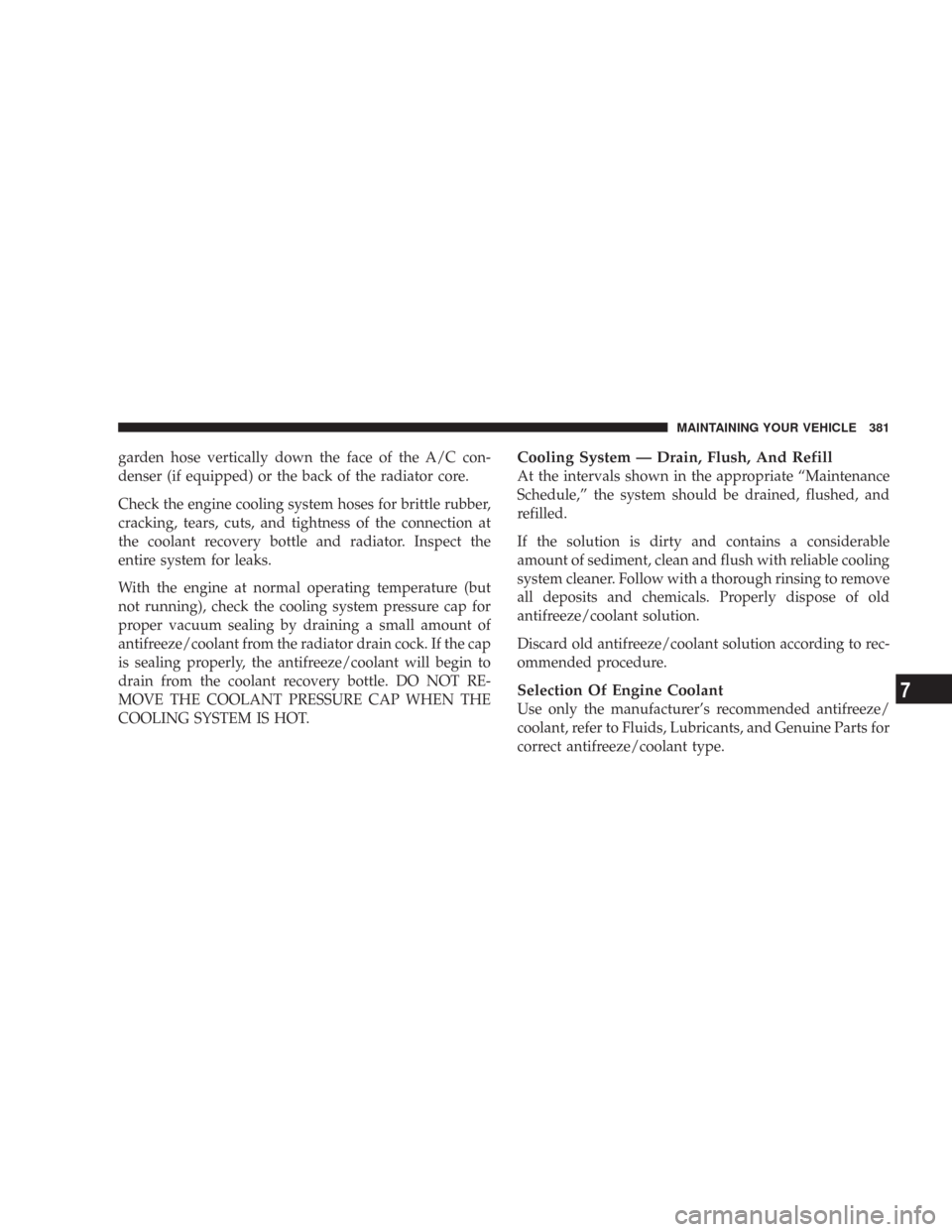
garden hose vertically down the face of the A/C con-
denser (if equipped) or the back of the radiator core.
Check the engine cooling system hoses for brittle rubber,
cracking, tears, cuts, and tightness of the connection at
the coolant recovery bottle and radiator. Inspect the
entire system for leaks.
With the engine at normal operating temperature (but
not running), check the cooling system pressure cap for
proper vacuum sealing by draining a small amount of
antifreeze/coolant from the radiator drain cock. If the cap
is sealing properly, the antifreeze/coolant will begin to
drain from the coolant recovery bottle. DO NOT RE-
MOVE THE COOLANT PRESSURE CAP WHEN THE
COOLING SYSTEM IS HOT.Cooling System — Drain, Flush, And Refill
At the intervals shown in the appropriate “Maintenance
Schedule,” the system should be drained, flushed, and
refilled.
If the solution is dirty and contains a considerable
amount of sediment, clean and flush with reliable cooling
system cleaner. Follow with a thorough rinsing to remove
all deposits and chemicals. Properly dispose of old
antifreeze/coolant solution.
Discard old antifreeze/coolant solution according to rec-
ommended procedure.
Selection Of Engine Coolant
Use only the manufacturer’s recommended antifreeze/
coolant, refer to Fluids, Lubricants, and Genuine Parts for
correct antifreeze/coolant type.
MAINTAINING YOUR VEHICLE 381
7
Page 382 of 467
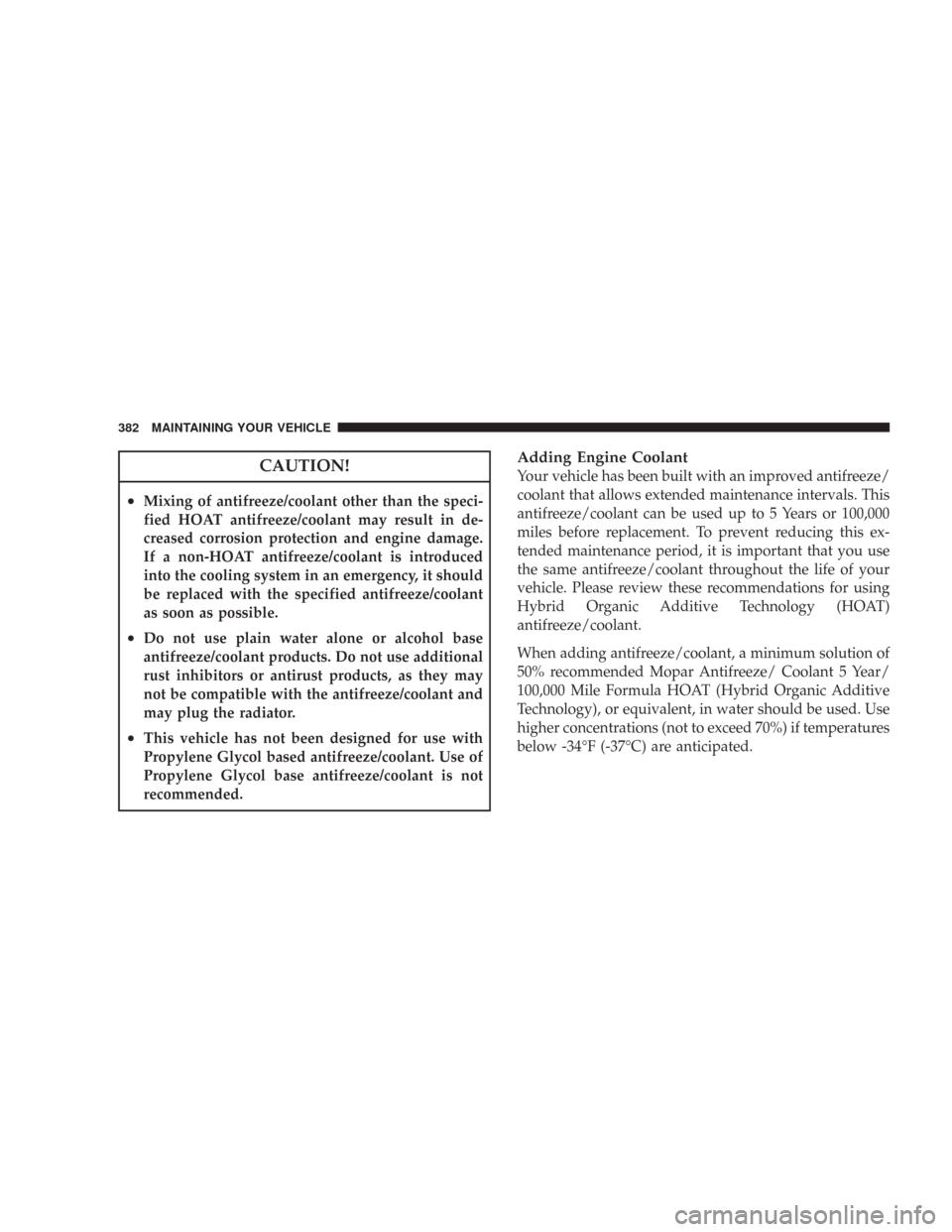
CAUTION!
•Mixing of antifreeze/coolant other than the speci-
fied HOAT antifreeze/coolant may result in de-
creased corrosion protection and engine damage.
If a non-HOAT antifreeze/coolant is introduced
into the cooling system in an emergency, it should
be replaced with the specified antifreeze/coolant
as soon as possible.
•Do not use plain water alone or alcohol base
antifreeze/coolant products. Do not use additional
rust inhibitors or antirust products, as they may
not be compatible with the antifreeze/coolant and
may plug the radiator.
•This vehicle has not been designed for use with
Propylene Glycol based antifreeze/coolant. Use of
Propylene Glycol base antifreeze/coolant is not
recommended.
Adding Engine Coolant
Your vehicle has been built with an improved antifreeze/
coolant that allows extended maintenance intervals. This
antifreeze/coolant can be used up to 5 Years or 100,000
miles before replacement. To prevent reducing this ex-
tended maintenance period, it is important that you use
the same antifreeze/coolant throughout the life of your
vehicle. Please review these recommendations for using
Hybrid Organic Additive Technology (HOAT)
antifreeze/coolant.
When adding antifreeze/coolant, a minimum solution of
50% recommended Mopar Antifreeze/ Coolant 5 Year/
100,000 Mile Formula HOAT (Hybrid Organic Additive
Technology), or equivalent, in water should be used. Use
higher concentrations (not to exceed 70%) if temperatures
below -34°F (-37°C) are anticipated.
382 MAINTAINING YOUR VEHICLE
Page 383 of 467
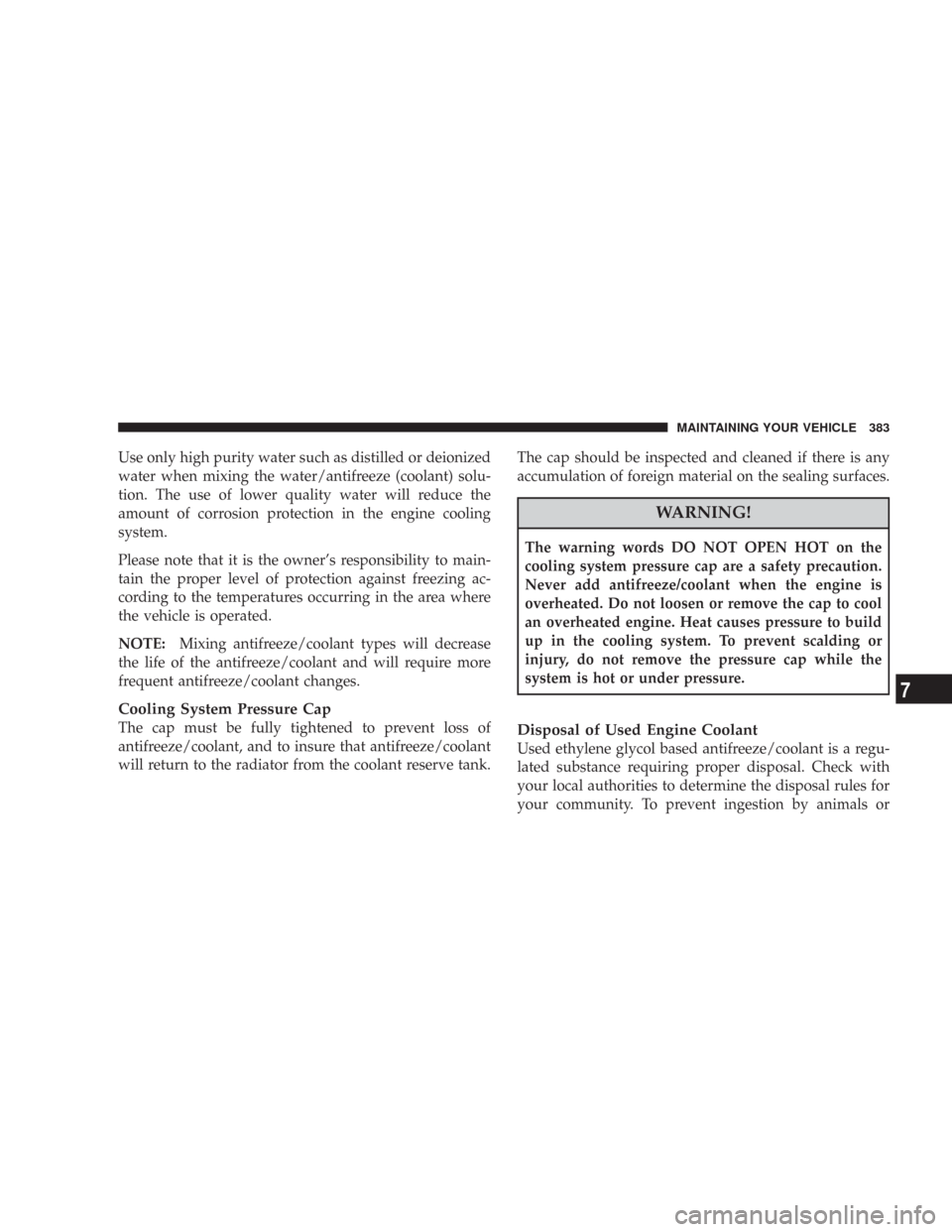
Use only high purity water such as distilled or deionized
water when mixing the water/antifreeze (coolant) solu-
tion. The use of lower quality water will reduce the
amount of corrosion protection in the engine cooling
system.
Please note that it is the owner’s responsibility to main-
tain the proper level of protection against freezing ac-
cording to the temperatures occurring in the area where
the vehicle is operated.
NOTE:Mixing antifreeze/coolant types will decrease
the life of the antifreeze/coolant and will require more
frequent antifreeze/coolant changes.
Cooling System Pressure Cap
The cap must be fully tightened to prevent loss of
antifreeze/coolant, and to insure that antifreeze/coolant
will return to the radiator from the coolant reserve tank.The cap should be inspected and cleaned if there is any
accumulation of foreign material on the sealing surfaces.
WARNING!
The warning words DO NOT OPEN HOT on the
cooling system pressure cap are a safety precaution.
Never add antifreeze/coolant when the engine is
overheated. Do not loosen or remove the cap to cool
an overheated engine. Heat causes pressure to build
up in the cooling system. To prevent scalding or
injury, do not remove the pressure cap while the
system is hot or under pressure.
Disposal of Used Engine Coolant
Used ethylene glycol based antifreeze/coolant is a regu-
lated substance requiring proper disposal. Check with
your local authorities to determine the disposal rules for
your community. To prevent ingestion by animals or
MAINTAINING YOUR VEHICLE 383
7
Page 384 of 467

children, do not store ethylene glycol based antifreeze/
coolant in open containers or allow it to remain in
puddles on the ground. If ingested by a child, contact a
physician immediately. Clean up any ground spills im-
mediately.
Engine Coolant Level
The coolant bottle provides a quick visual method for
determining that the coolant level is adequate. With the
engine idling, and warm to normal operating tempera-
ture, the level of the antifreeze/coolant in the bottle
should be between the ranges indicated on the bottle.
The radiator normally remains completely full, so there is
not need to remove the radiator cap unless checking for
antifreeze/coolant freeze point or replacing antifreeze/
coolant. Advise your service attendant of this. As long as
the engine operating temperature is satisfactory, the
coolant bottle need only be checked once a month.When additional antifreeze/coolant is needed to main-
tain the proper level, it should be added to the coolant
bottle. Do not overfill.
Points To Remember
NOTE:When the vehicle is stopped after a few miles of
operation, you may observe vapor coming from the front
of the engine compartment. This is normally a result of
moisture from rain, snow, or high humidity accumulat-
ing on the radiator and being vaporized when the
thermostat opens, allowing hot antifreeze/coolant to
enter the radiator.
If an examination of your engine compartment shows no
evidence of radiator or hose leaks, the vehicle may be
safely driven. The vapor will soon dissipate.
•Do not overfill the coolant bottle.
•Check antifreeze/coolant freeze point in the radiator
and in the coolant recovery bottle. If antifreeze/
384 MAINTAINING YOUR VEHICLE
Page 419 of 467

Schedule “B”
Follow this schedule if you usually operate your vehicle
under one or more of the following conditions.
•Day or night temperatures are below 32°F (0°C)
•Stop and go driving
•Excessive engine idling
•Driving in dusty conditions
•Short trips of less than 10 miles (16.2 km)
•More than 50% of your driving is at sustained high
speeds during hot weather, above 90°F (32°C)
•Trailer towing
•Taxi, police, or delivery service (commercial service)
•Off-road or desert driving
•If equipped for and operated with E-85 (ethanol)
fuel.
NOTE:IfANYof these apply to you then change your
engine oil every 3,000 miles (5 000 km) or 3 months,
whichever comes first and follow “Schedule B” of the
“Maintenance Schedules” section of this manual.
NOTE:IfANYof these apply to you then flush and
replace your engine coolant/anti-freeze every 102,000
miles (170 000 km) or 60 months, whichever comes first,
and follow “Schedule B” of the “Maintenance Schedules”
section of this manual.
SCHEDULE “B” 419
8
M
A
I
N
T
E
N
A
N
C
E
S
C
H
E
D
U
L
E
S
Page 452 of 467

Check Engine Light
(Malfunction Indicator Light).............208,366
Child Restraint....................64,65,71,75
Child Restraint Tether Anchors.............70,71
Child Seat.............................. 69
Climate Control......................... 252
Clock...........................219,235,246
Compact Disc (CD) Maintenance............. 251
Compass.............................. 211
Compass Calibration..................... 213
Console............................... 118
Console, Floor.......................... 118
Contract, Service........................ 442
Converter, Catalytic...................... 373
Cooling System......................... 380
Adding Coolant (Antifreeze).............. 382
Coolant Capacity...................... 412
Coolant Level......................... 384
Disposal of Used Coolant................ 383Drain, Flush, and Refill.................. 381
Inspection........................... 380
Points to Remember.................... 384
Pressure Cap......................... 383
Selection of Coolant (Antifreeze).........381,412
Temperature Gauge..................... 205
Corrosion Protection..................... 393
Crankcase Emission Control System.......... 375
Cruise Light........................... 205
Cup Holder............................ 117
Customer Assistance..................... 440
Data Recorder, Event...................... 62
Daytime Running Lights................... 101
Dealer Service.......................... 368
Defroster, Rear Window................... 195
Defroster, Windshield...............253,255,256
Delay (Intermittent) Wipers................. 101
Diagnostic System, Onboard................ 365
452 INDEX
Page 453 of 467
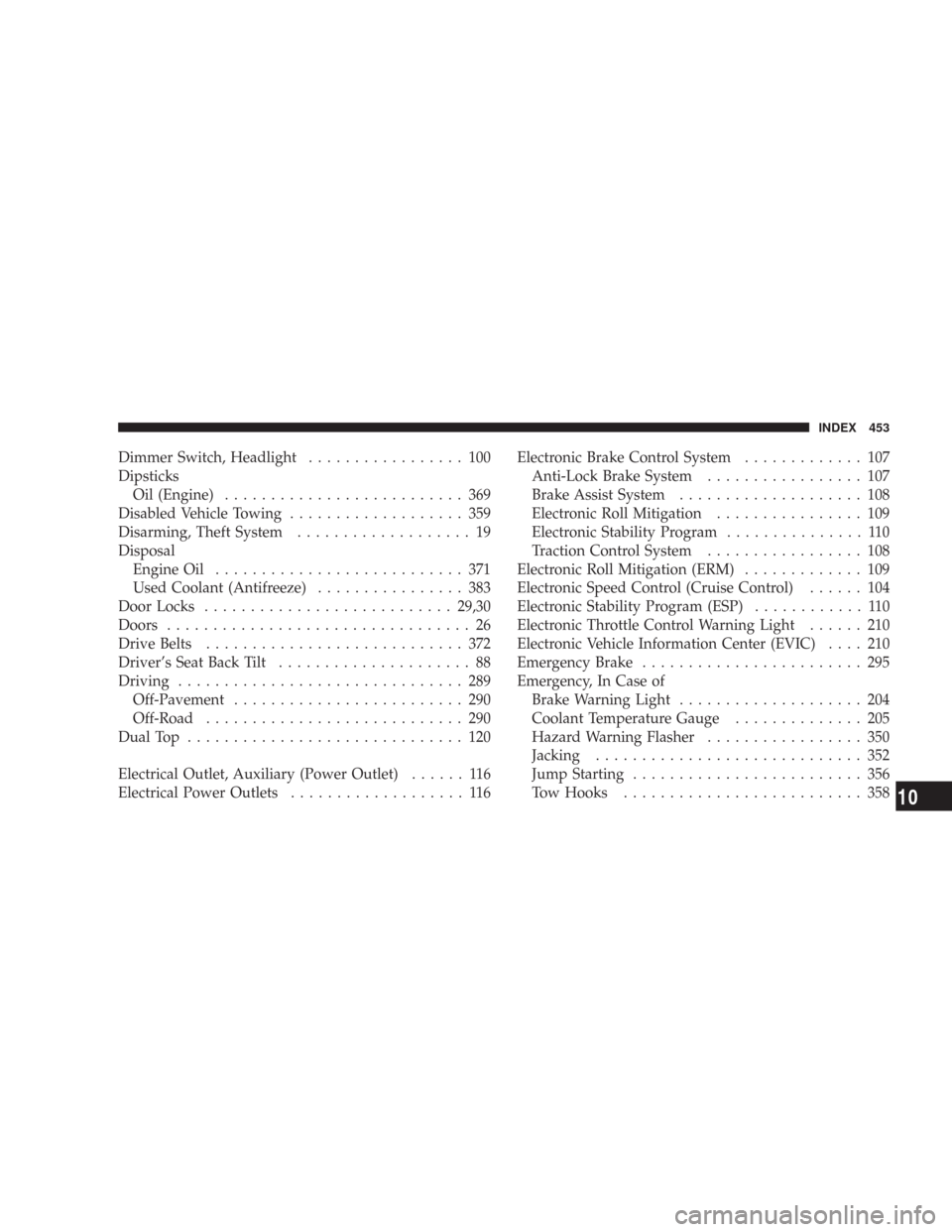
Dimmer Switch, Headlight................. 100
Dipsticks
Oil (Engine).......................... 369
Disabled Vehicle Towing................... 359
Disarming, Theft System................... 19
Disposal
Engine Oil........................... 371
Used Coolant (Antifreeze)................ 383
Door Locks...........................29,30
Doors................................. 26
Drive Belts............................ 372
Driver’s Seat Back Tilt..................... 88
Driving............................... 289
Off-Pavement......................... 290
Off-Road............................ 290
Dual Top.............................. 120
Electrical Outlet, Auxiliary (Power Outlet)...... 116
Electrical Power Outlets................... 116Electronic Brake Control System............. 107
Anti-Lock Brake System................. 107
Brake Assist System.................... 108
Electronic Roll Mitigation................ 109
Electronic Stability Program............... 110
Traction Control System................. 108
Electronic Roll Mitigation (ERM)............. 109
Electronic Speed Control (Cruise Control)...... 104
Electronic Stability Program (ESP)............ 110
Electronic Throttle Control Warning Light...... 210
Electronic Vehicle Information Center (EVIC).... 210
Emergency Brake........................ 295
Emergency, In Case of
Brake Warning Light.................... 204
Coolant Temperature Gauge.............. 205
Hazard Warning Flasher................. 350
Jacking............................. 352
Jump Starting......................... 356
Tow Hooks.......................... 358
INDEX 453
10
Page 455 of 467

Turn Signal.....................203,410,411
Flooded Engine Starting................... 266
Fluid Capacities......................... 412
Fluid Level Checks...................... 392
Automatic Transmission................. 388
Engine Oil........................... 369
Manual Transmission................... 391
Power Steering........................ 377
Fluids, Lubricants and Genuine Parts.......... 413
Fog Light Service........................ 410
Fog Lights..........................100,410
Fold and Tumble Rear Seat.................. 90
Folding Rear Seat........................ 93
Folding Windshield...................... 187
Four Wheel Drive....................... 280
Shifting............................. 282
Four Wheel Drive Operation................ 280
Four-Way Hazard Flasher.................. 350
Front Axle (Differential)................... 392Fuel................................. 321
Filler Cap (Gas Cap).................... 325
Filter............................... 375
Gasoline............................ 321
Gauge.............................. 202
Materials Added....................... 323
Octane Rating........................ 321
Requirements......................... 412
Tank Capacity........................ 412
Fuel System Caution................324,326,327
Fuses................................ 400
Gas Cap (Fuel Filler Cap)...............325,366
Gasoline (Fuel)......................... 321
Gasoline, Reformulated................... 322
Gasoline/Oxygenate Blends................ 322
Gauges
Coolant Temperature.................... 205
Fuel................................ 202
INDEX 455
10